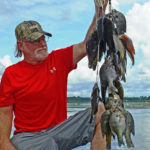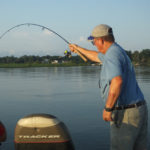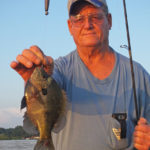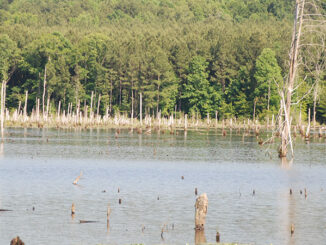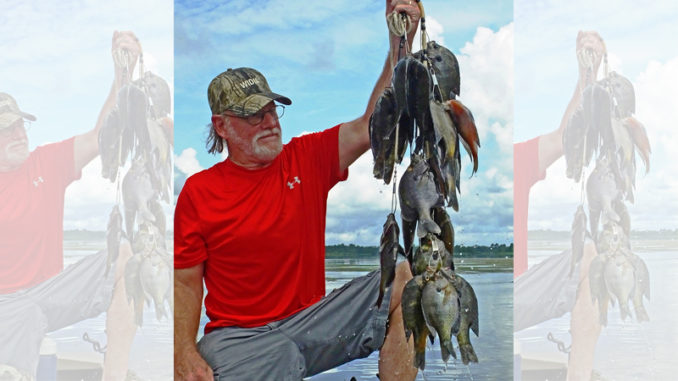
Find the right spot, and you can load the boat with Cooper River bream this month.
Wyn Mullins prepared a perfect summer setup for catching big fish. His boat was anchored on a Cooper River channel ledge at sunrise, just upstream from the junction of a small creek. An abundance of weedy growth flourished on the shallow flat between the two runs of deeper water, creating a perfect shallow point harboring miniscule aquatic munchies, attracting a variety of fish species.
Mullins deftly flipped his rig just beyond the weedy point, ground zero for big fish action.
Although this would be a prime target for July bass action, Mullins wasn’t after largemouth bass. He was flipping a cricket, seeking the first bull bream of the morning.
“Ya’ll better hurry; it’s fixing to happen,” Mullins said.
Before anyone else could wet a cricket, he leaned back to set the hook as the bobber twitched, then dove into the depths. Instead of swinging a smallish bream over the gunwales of the boat, he grabbed said gunwale, using it as leverage to hold on as his long fishing pole buried three eyes deep into the water.
This first bream tipped the digital scale to just over a pound, and by the end of the morning, it was nowhere near the largest bream hauled aboard.
“By summertime, even experienced bream fishermen let their minds wander to fishing opportunities for other species,” Mullins said. “Most say because the big bream have already bedded, they’re gone. My philosophy is that when they’re gone from the shallows, I’ll follow them to the deeper water in the Cooper River. It’s not a bed in terms of relating to spawning, but they still group up in big clusters and huge sizes in specific areas.”
Mullins, from North Charleston, said the Cooper is a fertile home for producing monster bream, as well as shellcrackers and largemouth bass. He has fished the river since the 1960s, and during July, he’ll focus on the patterns of these gigantic bream. The period from July through August and into September can be as productive as springtime for bream by fishing deep water with the right techniques.
“The trick is to fish deep water and to factor in water changes from the tidal flow,” Mullins said. “The combination of the current, depth and the type of cover and structure available determines where bream will be on a given day. They’re going to be near, if not in, deep water and close to nearby aquatic growth that harbors forage. The current will often push them to near the mouth of a pocket or creek junction or back deeper in a pocket, depending on the river level and tide. As the water rises, they’ll often move back in pockets a bit because they’ll have sufficient water depth.”
Mullins said time of day is not a huge influence for catching a lot of big bream in the Cooper River during July.
“The important aspect is to remember that tides are the lifeblood of this fishing,” he said. “Time of day will influence the heat, and that may impact the comfort of the fisherman, but it does little to impact these deep-water bream. I’ll often get out at sunrise just to beat the heat, but it’s for my comfort in that situation.”
Mullins said his bream fishing ranges over a wide area, from just below Pinopolis Dam more than 15 miles down the river. He’ll select different areas and focus on a specific stretch of water on that day. He said bream can be caught on any tide, but his favorite is either side of the high tide.
“Just prior to the high tide and then the falling off the high have been most-consistently productive for me,” he said. “I’ve found the action faster at this tide stage. In terms of catching big bream, odds are favorable to limit on any tide, it just takes me longer on a low tide. Generally, the tides are about three hours later than tides in Charleston if you’re planning a trip. But I go when I can, not just on my favored tide, because the deep-water fishing is still excellent.”
Mullins prefers light spinning tackle: a 7-foot, light action spinning rod for casting and straight-lining and a lightweight, 9-foot jigging pole for fishing in tight quarters. He opts for 6-pound test line with a No. 4 wire hook on the business end and a No. 3 split-shot about 8 inches up the line. He prefers a 5-inch balsa slip float with a stopper rigged for quick depth changes. He also rigs one rod to fish tight-line with no float, using the same hook and weight, when fishing directly under the boat.
“I prefer light line, but the bream make it unrealistic to use less than 6-pound test,” he said. “The technique is to fish the edges of the river, especially along areas where a defined weedline exists on a shallow flat dropping into the deep water of the river. We’ll fish from 8 feet down to 18 feet deep, but the big bream we hook fight hard to get into the weeds, especially when they get close to the surface. That’s why 6-pound test is necessary to consistently land them. I tried 4-pound test and got my heart — and line — broken too often.
“I’ll target steep drops into deep water such as an outside bend in the river, around the junctions of creek mouth and small cuts and points along the weedlines at the edge of the river,” he said. “Steep shorelines with heavy cover under the water are also ideal. Crickets make the best live bait but small spinners are good when I run out of crickets.”
Mullins said one key to finding the fish is to keep moving to find the right pattern for the specific tide.
“Once you find a place that holds fish, study what is happening in that specific spot,” he said. “How deep is the water, and how deep did you catch fish? Were you on the edge of the river or just inside the mouth of a feeder creek? Answer these questions and go find another similar spot.
“Sometimes, I’ll fish a little shallower on the outside bend of the river,” he said. “If I find good cover, such a blowdown, log or a dock where the current sweeps around the bend bream may be on the shallow range of that 8- to 18-foot depth pattern. On other places, such as the junction of a creek with the river, they may be found deeper even at the same point in the tide cycle.”
Mullins said a lot of the bream will weigh in excess of a pound, and he frequently catches them approaching 2 pounds during the summer — and the occasionally shellcracker considerably larger.
“Not every bream is going to weigh a pound, of course,” Mullins said. “But from all the many lakes and rivers I’ve fish in South Carolina, the Cooper River bream consistently produces the biggest bream I’ve found. And that’s true even during the summertime.”
DESTINATION INFORMATION
HOW TO GET THERE — The Cooper River flows from Lake Moultrie’s downstream approximately 30 miles to Charleston, where it dumps into Charleston Harbor. The Bushy Park Landing is a popular boat ramp near the Naval Weapons Station on Red Bank Road on the Black River, a mile or so from the Cooper. Dennis Landing is just southeast of the US 52 bridge over the Cooper, a mile or so downstream from Pinopolis Dam near Moncks Corner.
WHEN TO GO — Mid-July through September can provide some great fishing for bluegill in the deeper waters of the Cooper River.
BEST TECHNIQUES — Light spinning tackle or fiberglass poles are common on the Cooper River. Don’t go lighter than 6-pound test, as a big bream can do plenty of damage. Live crickets are the top baits, but small spinners will also work. Target areas where two deep runs meet, or where vegetation is present. Try to fish around the high end of the tide, either rising or falling.
FISHING INFO/GUIDES — Joe Dennis, J Hook Charters, Bonneau, 843-245-3762. See also Guides and Charters in Classifieds.
ACCOMMODATIONS — Berkeley County Chamber of Commerce, 843-761-8238 www.berkeleysc.org; Moncks Corner Chamber of Commerce, 843-761-8238, www.2chambers.com/monks.htm.
MAPS — Delorme’s S.C. Atlas and Gazetteer, 800-561-5105, www.delorme.com.

